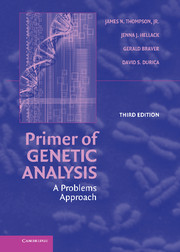Book contents
- Frontmatter
- Contents
- Preface
- Note on Genetic Symbols
- 1 Overview of Genetic Organization and Scale
- 2 Mitosis and Meiosis
- 3 Nucleic Acids: DNA and RNA
- 4 Basic Mendelian Genetics
- 5 Probability and Chi-Square
- 6 Sex-Linkage and Gene Interactions
- 7 Pedigree Analysis
- 8 Overview of Basic Statistical Testing
- 9 Quantitative Inheritance
- 10 Overview of Genetic Mapping
- 11 Assessing Chromosome Linkage Relationships
- 12 Linkage and Mapping in Diploids
- 13 Mapping in Bacteria and Viruses
- 14 Overview of Types of Genetic Change
- 15 Gene Mutation
- 16 Changes in Chromosome Number and Structure
- 17 Protein Synthesis and the Genetic Code
- 18 Gene Regulation and Development
- 19 Overview of Molecular Biology Techniques
- 20 DNA Mapping and Human Genome Analysis
- 21 Basic Population Genetics
- 22 Selection and Evolution
- 23 Practice Tests
- 24 Answers to Practice Tests and Crossword Puzzles
- 25 Landmarks in the History of Genetics
- Glossary
- Reference Tables
13 - Mapping in Bacteria and Viruses
Published online by Cambridge University Press: 05 June 2012
- Frontmatter
- Contents
- Preface
- Note on Genetic Symbols
- 1 Overview of Genetic Organization and Scale
- 2 Mitosis and Meiosis
- 3 Nucleic Acids: DNA and RNA
- 4 Basic Mendelian Genetics
- 5 Probability and Chi-Square
- 6 Sex-Linkage and Gene Interactions
- 7 Pedigree Analysis
- 8 Overview of Basic Statistical Testing
- 9 Quantitative Inheritance
- 10 Overview of Genetic Mapping
- 11 Assessing Chromosome Linkage Relationships
- 12 Linkage and Mapping in Diploids
- 13 Mapping in Bacteria and Viruses
- 14 Overview of Types of Genetic Change
- 15 Gene Mutation
- 16 Changes in Chromosome Number and Structure
- 17 Protein Synthesis and the Genetic Code
- 18 Gene Regulation and Development
- 19 Overview of Molecular Biology Techniques
- 20 DNA Mapping and Human Genome Analysis
- 21 Basic Population Genetics
- 22 Selection and Evolution
- 23 Practice Tests
- 24 Answers to Practice Tests and Crossword Puzzles
- 25 Landmarks in the History of Genetics
- Glossary
- Reference Tables
Summary
STUDY HINTS
Most of the material we have discussed so far in this primer has been directed at diploid animals and plants. Although the genetic code and role of DNA are essentially the same in eukaryotic and prokaryotic cells, there are important differences. A key difference is that eukaryotic cells have a nucleus (eu- true, kary- nucleus) and genetic transmission is based on the behavior of chromosomes during meiosis and mitosis. Prokaryotic cells, on the other hand, have no nucleus and are haploid. Since they do not have meiosis, they also lack the genetic transmission associated with sexual reproduction. Mendelian rules do not apply to them. In addition, there are also DNA elements, such as transposons, in eukaryotic cells that provide a special, but very important, exception to traditional genetic transfer.
There are, however, several mechanisms of genetic exchange. Although the method of DNA transfer differs in each case, it can result in a partial diploid for any genes that are carried by the DNA fragment entering the prokaryotic cell. These not only help generate genetic diversity, they also offer geneticists powerful tools to manipulate and study the prokaryotic genome.
▪ Transformation – small “naked” DNA fragments are transported into the cell directly from the cell's environment.
▪ Transduction – DNA picked up by a virus in one cell can be transferred to another cell when that virus infects it.
[…]
- Type
- Chapter
- Information
- Primer of Genetic AnalysisA Problems Approach, pp. 125 - 132Publisher: Cambridge University PressPrint publication year: 2007



